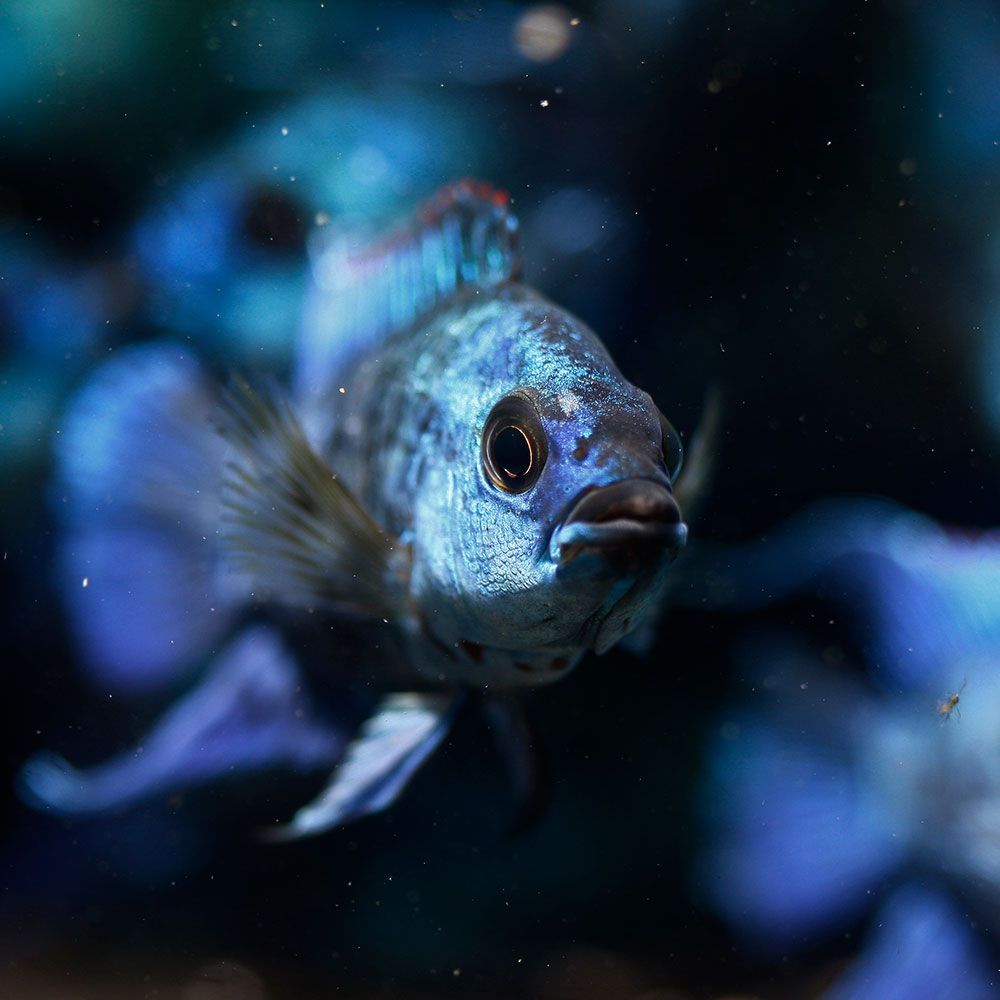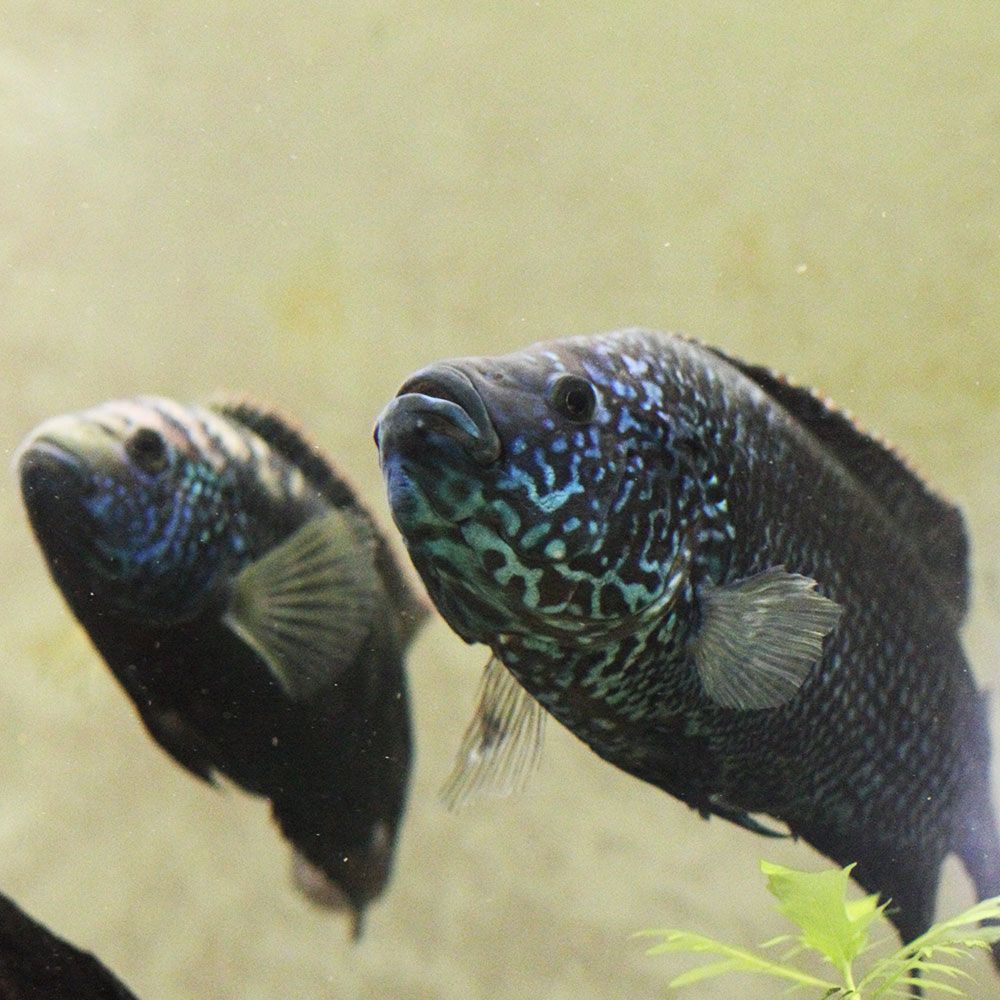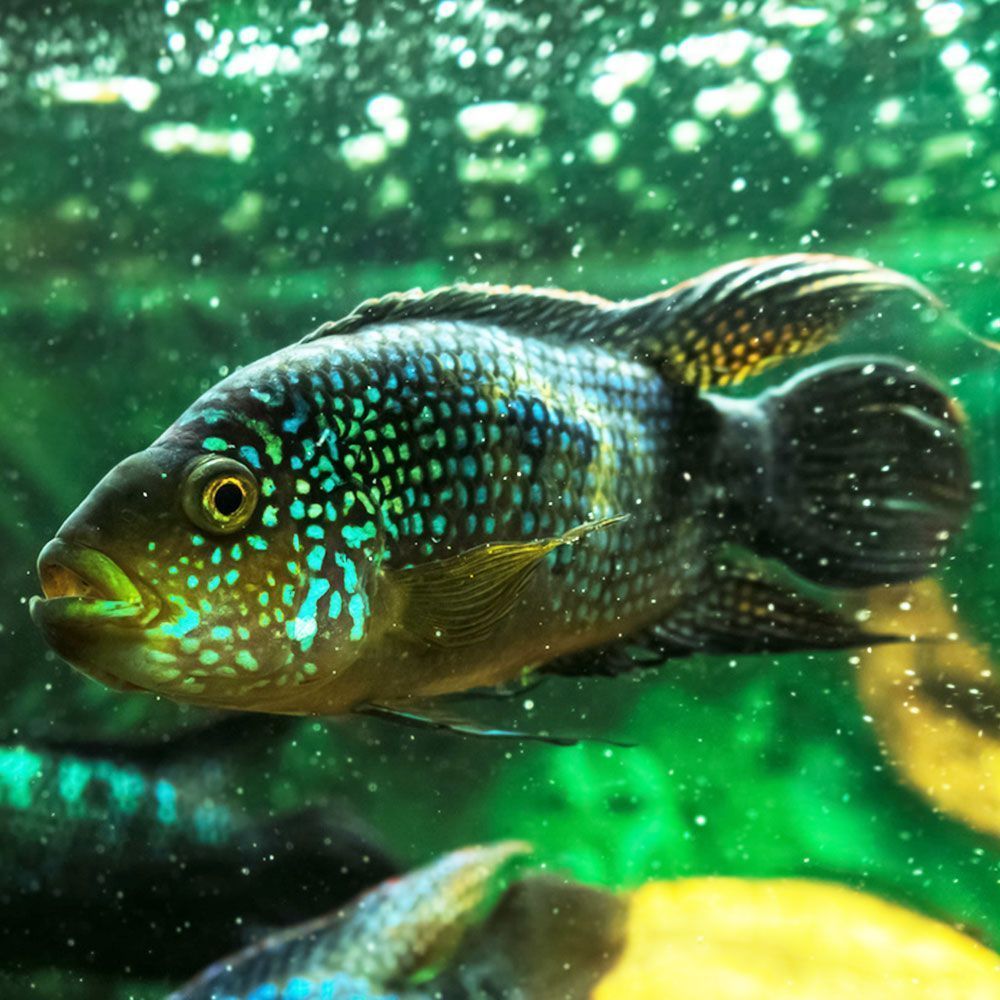If you want to build a stunning species-specific aquarium and have some experience under your belt, the Jack Dempsey fish will be a fantastic choice.
This colorful but fierce and strong fish will leave you mesmerized with its unique personality. It is also extremely disease-resistant and accepts most kinds of feed.
So, if you’re ready to get one, let’s dig right in!
What is a Jack Dempsey Fish?
Jack Dempsey fish is a freshwater fish that belongs to the Cichlidae family and is known for its colors and fierce nature.
| Origin | Southern Mexico to Honduras; Papaloapan River, Ulua River, Central and North America |
| Order | Perciformes |
| Family | Cichlidae |
| Scientific Name | Rocio octofasciata |
| Common Names | Jack Dempsey cichlid, or just Jack Dempsey |
| IUCN Red List Status | Least Concern |
| Appearance | Stocky oval body, pointy dorsal and anal fins, iridescent body |
| Size | 18-25 cm (7.1-9.8 in) |
| Lifespan | Up to 10-15 years or more |
| Temperament | Quite aggressive to conspecifics and other species, except its mate |
| Tank Level | Bottom to middle-level dwellers |
| Water Temperature | 72-86 °F (22-30 °C) |
| pH Level | 6.5-8.0 |
| Water Hardness | Up to 12 dGH |
| Care Level | Expert – Difficult |
| Minimum Tank Size | 125-gallon tank for a pair |
| Tank Environment | Spacious tank with lots of hiding areas |
| Diet | Omnivorous, but mostly carnivorous |
| Tank Mates | Usually only its own mate; but with special care: other South and Central American cichlids |
What is the Natural Habitat of Jack Dempsey Fish?
Jack Dempsey fish is naturally found in the benthopelagic zones of North American and Central American freshwater bodies.
From Southern Mexico to Honduras, in the Atlantic slope, the fish cohabit the Papaloapan River, Ulua River, Candelaria River, Ulua River, and Usumacinta River.
It is also a resident of Guatemala, Belize, and parts of the US.
Moreover, the species has also been accidentally introduced to Australia and Florida, where they survive as invasive species.
The fish is mainly found in richly vegetated sand or mud-bottomed creeks, canals, ditches, drainage, and swampy areas with warm waters. It feels more comfortable in the slow-flowing waters of the coastal plain.
According to the 2018 assessment by The IUCN Red List Status of Threatened Species, the fish was labeled Least Concern.
Which family does Jack Dempsey Fish belong to?
Jack Dempseys belong to the Perciformes order under the Cichlidae family. They are scientifically named Rocio octofasciata. But commonly, they are called Jack Dempsey cichlids, Jack Dempsy fish, or just Jack Dempseys.
However, they are also called by unique names depending on the locality of their natural habitat.
Fun Fact: The common name of the fish refers to the 1920s boxer Jack Dempsey. It is due to its aggression and strong facial features.
How does Jack Dempsey Fish look?

Now that you’re interested in this cichlid, let’s get to know about it more – both from the inside and outside!
What is the size of Jack Dempsey Fish?
Jack Dempsey cichlid can grow 18-25 cm (7.1-9.8 in).
What is the color of Jack Dempsey Fish?
This feisty cichlid is available in multiple color variants, namely – pink, electric pink, platinum, yellow, electric blue, black blue, and albino Jack Dempsey fish. It also comes in green and purple.
The naturally found Jack Dempsey cichlid has a black base color which changes from rosy pink to dusky shades in different areas. The fish also has metallic iridescent colors all over it and grey or whitish underbelly.
In the aquarium trade, the electric blue Jack Dempsey is the most popular. It has patches of iridescent green and blue.
The young fish look much more dull than the adults – usually grey or tan.
What are the Features of Jack Dempsey Fish?
The stocky oval-shaped fish has pointy dorsal and anal fins. The fish also has different colored iridescent flecks on its body, which sparkles like the morning dew. It also has small spots aligned in around 15 series.
How does a Male and Female Jack Dempsey Fish Differ?
The fins of the male Jack Dempsey fish are much longer and more pointy than females. The male fish also sports a round black dot around the center of his body and the base of his caudal fin, along with a red band on the anal and dorsal fins.
On the other hand, the female can be identified by a dark spot on her dorsal fin and a smaller dark spot near the lower corner of the gill cover. She also has much more rounded fins. The female fish is also not as brightly colored as the male.
What is the Behavior & Temperament of Jack Dempsey Fish?
The juvenile fish can live and grow with an entire school. But as the fish grows, it becomes more aggressive and territorial towards conspecifics.
Obviously, it also doesn’t tolerate other species that invade its space. However, it may not act the same towards its mate.
The fish is only suitable for well-researched community tanks.
What is the Lifespan of Jack Dempsey Fish?
In the wild, Jack Dempsey fish can survive up to 10 years. In captivity, the fish lives a bit longer, up to 15 years.
Author’s Note: The fish changes color and turns more black when it gets stressed or gradually as it gets older.
How to take care of Jack Dempsey Fish?

If you’re intrigued by the fish and can’t wait to bring it home, then let’s start preparing a suitable space for it!
What is the Tank Size for Jack Dempsey Fish?
When young, these fish must be kept in a group to help them find their mates. For a group of young fish, you can keep them in a 55-gallon tank. But once they sexually mature, the species becomes aggressive towards competitors.
For one adult Jack Dempsey fish, you need at least a 75-gallon tank.
But if you have a mated pair, some suggest a 90-gallon tank. But in my experience, a 125-gallon tank will keep your pair healthier.
What is the Water Chemistry for Jack Dempsey Fish?
Now, to ensure the optimal health of your Jack Dempsey fish, you must also maintain the most pristine conditions of water with these parameters:
- pH Levels: 6.5-8.0
- Water Temperature: 72-86 °F (22-30 °C)
- Water Hardness: Up to 12 dGH
- Carbonate Hardness: 4-6 dKH
- Ammonia: 0 ppm
- Nitrite: 0 ppm
- Nitrate: Below 30 ppm
What is the Tank Environment for Jack Dempsey Fish?
Once you know about the tank size and the water parameters, you must fill in your tank with suitable things to make the fish feel at home. So, let’s get started!
Which Substrate is needed for Jack Dempsey Fish?
This pet fish loves to dig in the substrate and play around. So, layer the bottom with soft and fine sand substrate. It will protect the Jack Dempsey fish from unnecessary injury.
You can also get dark-colored sand, as the fish looks pretty attractive against it.
Which Plants are needed for Jack Dempsey Fish?
Avoid tender and weak-rooted plants, as this fish loves to nibble on them. Instead, you must choose strong-rooted, hard-stemmed, potted plants.
Since Jack Dempsey fish also likes to modify the substrate, stick to floating plants like frogbit, pennywort, hornwort, Java ferns, Java moss, or water sprite.
What is the Lighting required for Jack Dempsey Fish?
The Jack Dempsey fish is comfortable with all kinds of lighting, so you can choose anything between normal and moderate. Or, you can choose according to the lighting needs of your aquarium plants.
What type of Décor is required for Jack Dempsey Fish?
Make the cichlid feel more at home by adding sunken driftwood, caves, and large rocks. If the fish ever felt insecure, it would hide among these decor.
Which type of Filtration is needed for Jack Dempsey Fish?
The bulky fish produces a lot of waste, so you must install an efficient oxygenating filtration system.
You can opt for a hang-on back filter for better affordability or canister filters for higher efficiency but less affordability. You must also perform regular water changes.
What should be the Water Flow Rate for Jack Dempsey Fish?
Similar to its natural habitat, the fish likes a slow to moderate flow rate in the tank.
Fish Care Tip: Though the fish can withstand a varied range of temperatures, try to stay near the lower side of the range. This is because warmer temperature makes the fish more aggressive.
What type of food does Jack Dempsey Fish eat?
The fish is omnivorous, but it prefers carnivorous feed the most. It accepts all kinds of feed, whether live, frozen, freeze-dried, or flakes. Some of the best dietary components for Jack Dempsey fish are:
- High-quality cichlid pellets
- Small fish
- Shrimps
- Prawns
- Mussels
- Calamari
- Snails
- Brine shrimp
- Bloodworm
- Tubifex
- Mosquito larvae
- Chopped veggies, like lettuce and cabbage
- Spirulina
- Chopped fruits
- Mixture of homemade feed in gelatin
You must feed the young fish 2-3 times a day for speedy growth and the adult fish 1-2 times daily for 2 minutes for each meal. Avoid any mammalian meat like beef or chicken heart as it’s hard to digest for the species.
What are the Tank Mates for Jack Dempsey Fish?
It’s better to keep the aggressive Jack Dempsey fish all alone or with a mated pair in a species-specific tank.
However, if you want to make a community tank, you must follow these rules:
- Make sure you or someone else is always there to monitor the tank throughout the day.
- Or, raise all the possible tank mates together with the Dempseys to make them more tolerant towards them.
Once that’s settled, get a tank larger than 150 gallons. You can then add:
- Texas cichlid
- Salvin’s cichlid
- Red terror cichlid
- Oscar fish
- Convict cichlid
- Firemouth cichlid
- Jaguar cichlid
- Silver dollar fish
- Pictus catfish
Which Tank Mates to Avoid for Jack Dempsey Fish?
The Jack Dempsey fish is not a good choice for a community tank with small fish. So, avoid these species at all costs:
- Tiger barbs
- Guppies
- Platies
- Harlequin rasboras
- Tetras
- Freshwater snails
- Shrimps
You must also avoid:
- Docile fish, even if it’s big and minds its business
- Extremely aggressive fish as they’ll both injure or kill them.
What are the Common Diseases in Jack Dempsey Fish?
So long you upkeep a pristine tank and water conditions and a balanced diet, the fish won’t easily fall sick. However, you must also be prepared to deal with these diseases.
| Disease Name | Causes | Symptoms | Treatment |
|---|---|---|---|
| Ich | Protozoan Parasitic Infection | White spots, flashing, inactivity, appetite loss | Add ich medicine or aquarium salts, raise the water temperature |
| Columnaris | Bacterial Infection | Frayed fins, white or grey patches, inactivity, appetite loss | Enhance water quality, reduce stress, administer antibiotics |
| Fin rot | Bacterial Infection | Fin fraying and/or disintegration, fin discoloration/redness, inactivity, appetite loss | Improve water quality, remove physically injurious objects, add antibiotics |
| Hexamita | Protozoan Parasitic Infection | Color loss, hemorrhage on head, red bowels, big sores or holes, appetite loss | Antifungal medicine administration |
| Skin flukes | Parasitic Infection | Excess mucus secretion, red spots, erratic breathing, hazy skin, scale loss, inactivity, appetite loss | Improved water quality, improved diet, oral medicines, medicated baths, injections |
Quick Tip: Before introducing any new item like plants or decor, clean them properly to avoid parasites in the tank.
How to Breed Jack Dempsey Cichlid?
Among cichlids, the Jack Dempsey fish is one of the most easily bred in the aquarium. But you must know about the following before you try to breed them:
- Due to their aggression, they may hurt each other. You need to be experienced in breeding them.
- You must raise a small school of Jack Dempsey fish and let the male choose its own partner and not forcibly pair them.
- The wild-bred Jack Dempsey fish sexually matures at 12 months, and for the captive-bred ones, it’s 6 months.
How to Prepare the Breeding Tank for Jack Dempsey Fish?
You need the right breeding setup to succeed and make it less stressful for yourself and the fish. The fish is a substrate egg-layer. So, keep large smooth flat stones and pots.
You can also keep one corner of the tank clear of substrates. This will aid the fish as the pair prefers a clean spawning site. Recommended breeding water temperature is 86 °F (30 °C).
Introduction
Place a divider in between the tank and place the male and female fish on either side. Keep the pair on a nutritious, high-protein diet of bloodworms.
When both the fish’s color darkens, they are ready to mate. You can remove the divider and allow them access to each other.
Note: If the color of the female fish doesn’t darken, you must not remove the divider. Otherwise, the male will chase and harass the female and might even kill her.
What is the Mating Ritual for Jack Dempsey Fish?
When the fish are ready, the male fish tries to woo the female by dancing around her. He shows off his colors to coax her into laying eggs. He will also prepare a clean space for her to lay eggs.
Once she’s ready, she will lay around 500-800 eggs. The male then fertilizes the eggs.
What is the Incubation period for Jack Dempsey Fish eggs?
After the spawning, the female fish guards the eggs throughout the incubation period, i.e., 3-6 days, depending on the water conditions.
Within the incubation phase, the parent fish pair digs multiple pits in the substrate. Then they hide the hatched fry in the substrate and pits to protect them.
During this phase, feed them parent fish plenty more than usual. The pair will eat enough to nourish themselves, the female fish crushes the rest to feed their fry and the male protects the territory. This biparental care continues until the fry becomes free-flowing.
When do Jack Dempsey Fish Parents and Fry Separate?
Once the fry is 3-days old, they become free swimmers. The parent pair might mistake them for food and consume them. So, separate the parent pair from them.
Now, you must raise the fry with commercial fry food, baby brine shrimp, and microworms until they are adults.
Breeding Tip: Sometimes, the parent pair may suddenly break into a fight and start eating the eggs or fries. If you notice any hostility between the two, remove the male fish from the tank.
How to Buy Jack Dempsey Fish?
- The common color variants of Jack Dempsey fish are pretty affordable. But if you want to get an uncommon color, be prepared to shell out more money.
- Avoid buying male and female fish from different stores. Otherwise, when made to be bred, genetically mutated fry may be born, which may or may not be feasible.
A word from FishInAquarium
The Jack Dempsey is an amazing, brightly colored big fish to keep you entertained for the long haul. Its dramatic expression and mood will amuse you, to say the least.
With that said, if this article convinced you to house the fish, don’t forget to forward the article to other enthusiasts in your community. But if something’s still bugging you, mail us right away, and we’ll have you covered!


